Ammonia-Based Aeration Control & Energy Efficiency: Lessons from Brockton AWRF’s Dual Aeration Systems
The Brockton Advanced Water Reclamation Facility (AWRF) in Brockton, MA, is a 14 MGD facility that utilizes YSI’s IQ SensorNet to optimize its 4-stage Bardenpho aeration process. These water quality sensors help Brockton effectively reduce total nitrogen and meet a stringent effluent limit of 3 mg/L. The integration of IQ SensorNet provides accurate, continuous monitoring, enabling precise aeration control that directly contributes to energy savings.
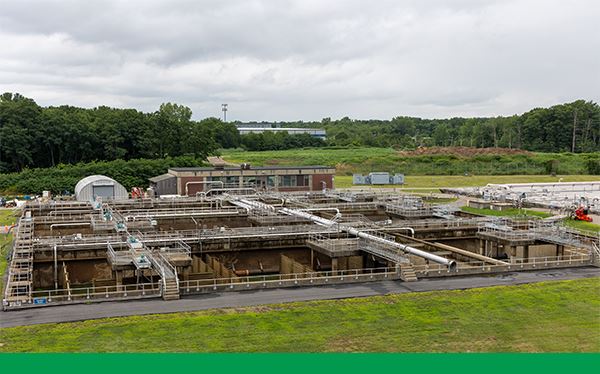
Brockton Advanced Water Reclamation Facility – North Basins
Brockton AWRF’s Treatment Process and Sensor Placement
Brockton AWRF’s aeration basins are equipped with a comprehensive suite of water quality sensors. Each aeration basin features three FDO sensors to monitor dissolved oxygen (DO) levels in the aerobic and post-aerobic zones. Additionally, two NitraVis UV-nitrate sensors are positioned in the pre-and post-anoxic zones to track denitrification, one SensoLyt pH sensor is located at the effluent to monitor pH, and one AmmoLyt ion-selective electrode (ISE) ammonia sensor is placed in the aerobic zone where ammonia levels fluctuate between 1 to 10 mg/L daily.
Placement of the ammonium sensor is critical for Ammonia-Based Aeration Control (ABAC) at the plant. A pilot study determined that probes reading greater than 1 mg/L ammonia for most of the day are optimally positioned for process control. Notably, nutrient loading variations led to different sensor placements in the South aeration train.
Online Ammonium Sensor Placement for Improved ABAC Control
Learn more about the pilot study and discover how the team at Brockton optimized ABAC by experimenting with ammonium sensor placement, leading to improved efficiency and lower energy use.
Aeration Control Strategies at Brockton AWRF
Following a series of upgrades and trials over a five-year period, the North aeration basins were brought online with ammonia-based aeration control. However, the South aeration basins continue to operate on a dissolved oxygen-based control strategy.
Currently, the North basins operate on an ammonia-based aeration control scheme with a variable setpoint of 1 to 5 mg/L NH4, guided by the ammonium sensor located in the aerobic zone. In contrast, the South basins employ DO control at a fixed setpoint of 2.5 mg/L, using a DO sensor positioned near the end of the aerobic zone.
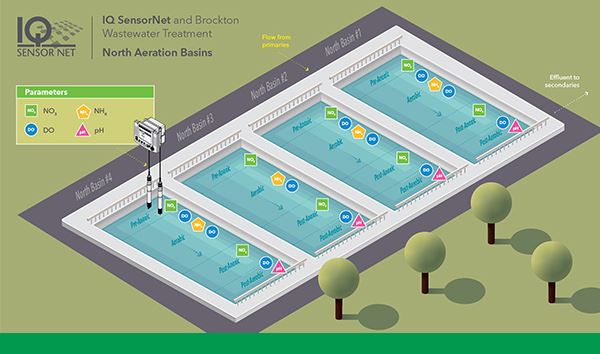
Diagram depicting the sensor locations at the North aeration basins at the plant
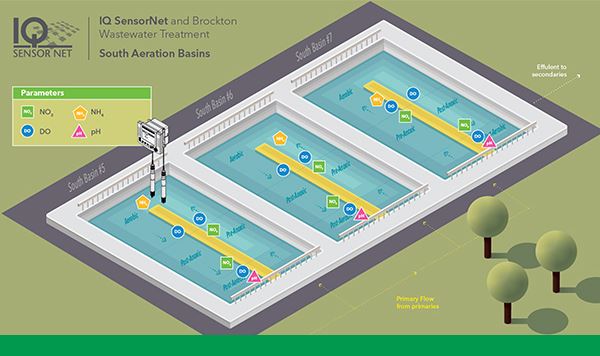
Diagram depicting the sensor locations at the South aeration basins at the plant
“One feature of the ion selective electrode I really like is that they seem impervious to pain.” -John Downey
Sensor Preventative Maintenance Schedule
John Downey, Brockton’s Instrumentation Technician, is responsible for maintaining the accuracy and reliability of the facility’s online sensors. Both the DO sensors in the South basins and the ammonium sensors in the North basins, which serve as critical control points, follow a strict preventative maintenance schedule.
The DO sensors are cleaned and checked against an optical handheld device weekly. With twenty-one DO sensors in total (three per aeration basin), this process takes about 5 hours. John’s maintenance routine includes reviewing the past 24 hours of DO data for anomalies, wiping the sensors clean with a damp towel, and then comparing each sensor’s reading to those from a handheld probe, ensuring a minimum 3-minute stabilization time.
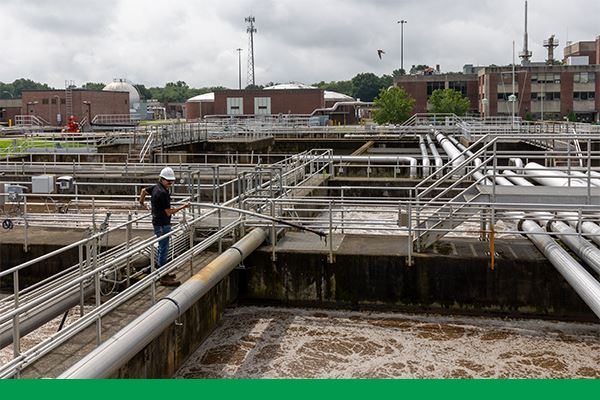
John Downey performing maintenance on the AmmoLyt ammonium ISE sensor in the North basins
The ammonium sensors are checked monthly against grab samples. The laboratory test takes approximately 20 minutes, so the entire process takes about 40 minutes per sensor, or 6-8 hours for all seven basins. John emphasizes that it’s best to take reference samples when the online probe reads between 1 and 2.5 mg/L. He immediately filters the grab samples to avoid ammonium concentration changes that can skew results. Adjustments to the sensor slope are made when readings are above 1 ppm for optimal accuracy.
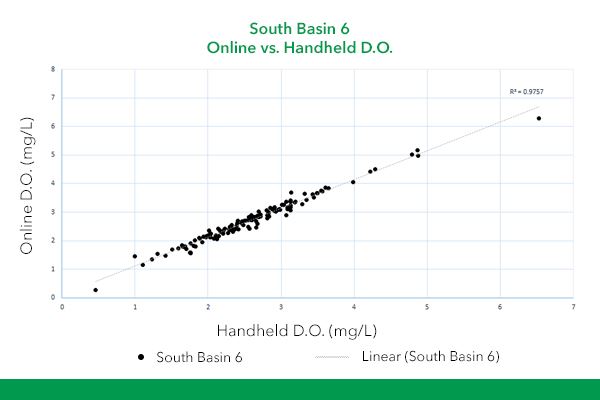
Graph of online DO vs. weekly handheld DO spot sampling over a 3-year period
Expert Tip from John Downey
“Reference samples should be taken when the actual concentration of ammonium in the basin is 2.5 ppm or less. The reason for this is acuity of measurement. Commercially available grab sampling for ammonia in the field is typically offered at 0 to 2.5 ppm and 0 to 50 ppm range. The 0 to 2.5 ppm range allows us greater certainty about the concentration of the grab. The other requirement is to filter the grab immediately, as the concentration of ammonium can change rapidly and skew your results.”
Comparison of Aeration Control Methods at Brockton: Ammonia-Based vs. Dissolved Oxygen Control
Brockton AWRF is unique in that it operates two different aeration control schemes, providing a valuable opportunity to directly compare the energy efficiency of ammonia-based aeration control (used in the North trains) and dissolved oxygen-based control (used in the South trains). This comparison highlights how different control strategies can significantly impact energy consumption.
The North aeration trains, which run on ammonia-based aeration control, are powered by two 300HP, one 200HP, and one 150HP turbo blower, providing a total of 950HP. Ammonia-based control allows these blowers to dynamically adjust their output based on real-time ammonia concentrations.
By monitoring ammonia levels, the system prevents over-aeration, optimizing blower usage to meet the required treatment efficiency without unnecessary energy expenditure. This precise, demand-driven aeration strategy means the system can efficiently ramp up blower output during peak load times and scale back during low load periods, reducing energy waste.
In contrast, the South aeration trains, which use DO-based control, are powered by three older 300HP centrifugal blowers and two newer 150HP turbo blowers, providing a total of 1,200HP. DO-based control systems maintain a constant dissolved oxygen setpoint, typically around 2.5 mg/L.
While effective at ensuring proper oxygenation, this method can lead to periods of over-aeration, especially when wastewater loads fluctuate. Since the control strategy is less responsive to real-time changes in ammonia levels, the blowers may continue running at higher outputs even when unnecessary, leading to higher energy consumption.
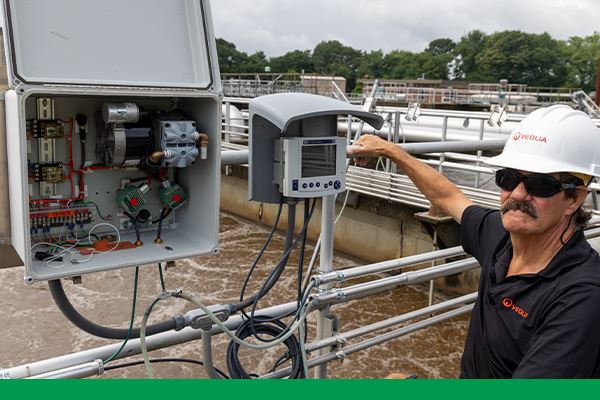
John Downey checks sensor readings on an IQ SensorNet 2020 3G controller
Energy Consumption Data for a Single Month
Data from the month of June 2024, taken from Brockton’s SCADA system, provides insight into the energy performance of the two systems. For this analysis, it’s important to consider that North aeration basin 1 was offline for maintenance, and primary clarifier 3 was also out of service, affecting flow distribution. These factors slightly skewed the data, but the results are still revealing.
The energy consumption for the North basins, which run on ammonia-based control, was 10,858 kWh/MGD for the month of June. In comparison, the South basins, which use DO-based control, consumed 19,737 kWh/MGD. This means that the North basins required 45% less energy per MGD of wastewater treated, making them 1.8x more efficient than the South basins. The ammonia-based control system allowed the North basins to better match blower output to actual process demands, reducing unnecessary energy use without compromising treatment quality.
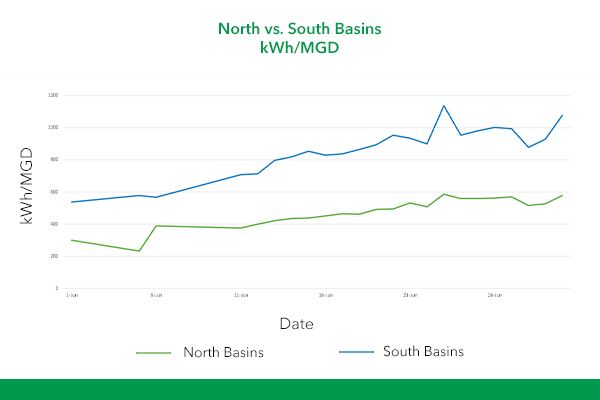
Blower Energy Performance Normalized for Volume of Wastewater Flow
Why the Difference?
The key difference between the two systems lies in how they control aeration based on process conditions.
Ammonia-based aeration control offers a more precise method by monitoring and adjusting to real-time ammonia concentrations, enabling the system to avoid over-aeration during periods of lower demand.
In contrast, DO-based control maintains a fixed oxygen setpoint, which can result in over-aeration when ammonia levels are low, but the system still delivers full oxygen.
Additionally, ammonia-based control benefits from variable setpoints, allowing the system to adapt to diurnal changes in wastewater load. During peak load periods, blower output increases in response to rising ammonia levels, but when the load drops, the system automatically scales back to conserve energy. DO-based systems, by contrast, do not adjust as flexibly, resulting in higher overall energy use.
Watch a Webinar to Learn More About Brockton’s Treatment Process
Optimizing Wastewater Treatment - Insights from Brockton AWRF
Gain more valuable insights into the use of online sensors for aeration control and Brockton’s innovative approach to ensuring reliable sensor data.
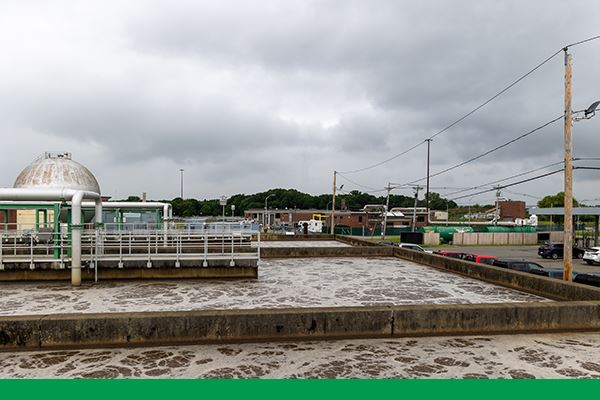
Brockton AWRF South Aeration Basins
Energy Consumption Data for a Single Month
Though this data focuses on the single month of June, Brockton AWRF has seen consistent energy savings with ammonia-based aeration control. The ability to respond dynamically to real-time process conditions has proven to be a key factor in reducing energy consumption while still maintaining high treatment efficiency.
Conclusion
Brockton AWRF’s experience demonstrates how YSI IQ SensorNet enhances wastewater treatment by ensuring regulatory compliance while achieving significant energy savings. By leveraging advanced sensor technologies and proper maintenance practices, Brockton operates efficiently with optimal aeration control strategies. As illustrated by John Downey’s preventative maintenance routines, maintaining reliable sensor performance is crucial for achieving energy-efficiency wastewater treatment.